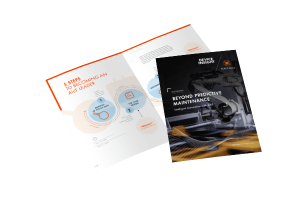Artificial intelligence (AI) is a much-discussed topic that can sometimes be seen as a double-edged sword. On the one hand, it revolutionizes the industry and fundamentally improves common processes and manufacturing methods, but on the other hand, AI is already feared as the big job killer that could make thousands of industry workers obsolete. What is the true status quo in terms of AI and where is this technology already in use?


If you look closely, AI has already arrived in people’s everyday lives – regardless of the industrial context – in the form of voice assistants in smartphones or home systems including Alexa and Google Home, but also in intelligent route planning that is able to incorporate road works and traffic jams in real time, or as product recommendations in e-commerce.
In industry, in contrast, AI is far from being as widely used as you might think. An example of this is predictive maintenance: according to a recent bitkom Survey, 15 percent of respondents believe that predictive maintenance is already an industry standard. In fact, predictive maintenance is currently used in a mere two percent of companies. The enormous potential of artificial intelligence is therefore far from being exhausted in the manufacturing industry and its use is still in its infancy in Germany.
All agree that AI is a future technology of the highest relevance and indispensable for sustainable business success. These are the results of a study by Deloitte, for which AI experts were surveyed worldwide, including 200 German decision-makers. The will to use AI is definitely there. There is however a wide lack of implementation. Above all, there is a general lack of technical know-how and company resources. AI specialists and skilled workers, on the other hand, are scarce and are correspondingly sought after in the labor market.
One way out of this situation is the “AI-as-a-Service” approach or the purchase of ready to use AI solutions. They make it possible to approach and implement AI projects, even if there is a lower level of knowledge or fewer staff in the company. This approach does have its disadvantages: With “off the shelf” AI, a company’s individual framework conditions and challenges can only be addressed insufficiently. Basically, the focus of companies is on AI projects with small, feasible use cases that deliver rapid added value. On average, projects in this country pay for themselves within 1-2 years, faster than the international average.
Despite all the positive developments, certain reservations remain. Skeptics fear that the technology could subjugate people instead of supporting them. In fact, repetitive tasks can be taken away from people, freeing up time to focus on other, more creative processes. In reality we are still a long way from ideas from the world of science fiction in which intelligent machines “take over” power. At present, it is generally the case that the AI is given a clearly defined application framework with precise tasks and objectives – and it does not deviate from this.
What exactly are the current applications for AI in industry? By far the most common and well-known use case is – as mentioned before – predictive maintenance. Thanks to predictive maintenance, technical errors and problems in the production process can be detected and eliminated before machines fail and production comes to a standstill.
Another frequent field of application is quality inspection and assurance. Here, by means of intelligent image recognition, optical inspections by AI applications can help to carry out error or process analyses. Concrete examples include surface inspection, measurement of size and shape, completeness check, object recognition as well as position recognition.
In industrial product design, for example, components are already designed in a highly optimized way by means of complex AI calculations based on Big Data. For example, weight is reduced during the development phase, raw materials are used optimally, and costs are saved from the outset.
How well these and other AI use cases work in practice, however, depends on the available data, keyword Big Data. Without data, AI application algorithms cannot be trained. The systematic linking of IoT and artificial intelligence has, correspondingly, great potential. Device Insight builds on this knowledge together with Swedish AI specialist Sentian, offering an innovative approach to optimizing production processes in an integrated manner with its joint “Artificial Intelligence of Things” (AIoT) approach. Machine learning can be used to reduce deviations in the production process and significantly increase overall quality and yield.

The whitepaper “Beyond Predictive Maintenance – Intelligent Automation with AIoT” provides a well-founded insight into this subject, including practical examples and recommended steps for implementation.


Delivering excellence in IoT. We are an IoT Solution Provider for Smart Products, Connected Vehicles, Smart City, Smart Energy and Smart Production.